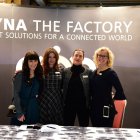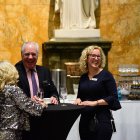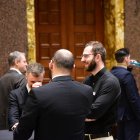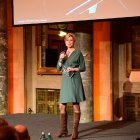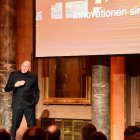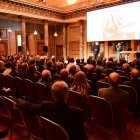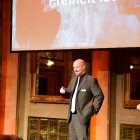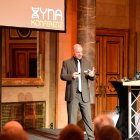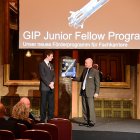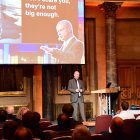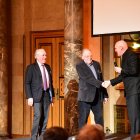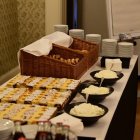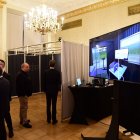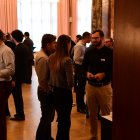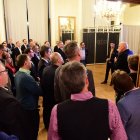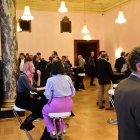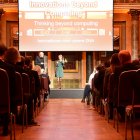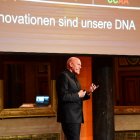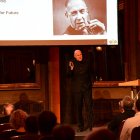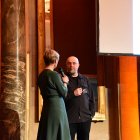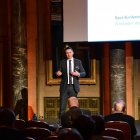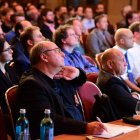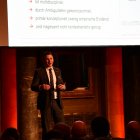Innovations Beyond Computing
14. Xyna Konferenz 21.11.2019 at the Kurhaus, Wiesbaden

Video reviews
"Short Review"
A review of the GIP Research Institute's Xyna Conference 2019 on 21 Nov 2019 at the Kurhaus, Wiesbaden.
"Innovation im Dialog"
Dr. Bernd Reifenhäuser and Petra Florin discuss the term innovation in the opening talk of the Xyna Conference 2019, true to the conference theme "Innovations Beyond Computing".
If you want to watch embedded videos on this page, personal data (IP address) will be sent to the operator of the video portal (here youtube.com) and cookies will be set on your device. Therefore, it is possible that the video provider stores your accesses and can analyze your behavior. By clicking on "PLAY VIDEO" you consent to the data processing and the setting of cookies.
For more information on data protection, click here: Data Protection
Play VideoIf you want to watch embedded videos on this page, personal data (IP address) will be sent to the operator of the video portal (here youtube.com) and cookies will be set on your device. Therefore, it is possible that the video provider stores your accesses and can analyze your behavior. By clicking on "PLAY VIDEO" you consent to the data processing and the setting of cookies.
For more information on data protection, click here: Data Protection
Play VideoFrom Leonardo da Vinci to DNA-Computing
The 14th Xyna Conference was all about innovation
Mainz/Wiesbaden - How are new ideas created? How will synthetic biology change our lives? What characterizes social innovations? "Innovations Beyond Computing" was the motto of the 14th Xyna conference held by the Mainz-based software house GIP AG. More than 250 guests from the telecommunications and IT industry met at the Wiesbaden Kurhaus on November 21, 2019, to learn about and exchange ideas on the topic. "Innovations are the DNA of our company," said GIP CEO Dr. Bernd Reifenhäuser."Therefore, nothing was more obvious than to make them the topic of our conference."
Dr. Bernd Reifenhäuser and Petra Florin open the conference
"If one really wants to create something new, one has to be a little crazy"
Rethinking innovations
How do new ideas come about? Dr. Bernd Reifenhäuser opened his presentation on innovations with this leading question. "If you really want to create something new, you have to be a little crazy," he quoted the physicist and Nobel Prize winner Niels Bohr. Reifenhäuser pinpointed the human brain's tendency to stay in tried-and-tested thought paths when solving problems as the biggest obstacle to innovation. This so-called path dependency, however, can be overcome by an interdisciplinary approach. He illustrated this with the example of the universal genius Leonardo da Vinci, who became famous as a painter and sculptor, but was also an outstanding engineer and scientist. The Bauhaus also linked various disciplines, including architecture, furniture making, painting and textile design, and thus created an entirely new style.
Reifenhäuser expects a technological leap from the linking of two originally distant disciplines, namely computer technology and synthetic biology. "DNA computing will continue to evolve over the next decade and open up a completely new field," the GIP executive predicted. He sees applications in a variety of fields, including energy, pharmacology, medicine, agriculture and the environment. "All of a sudden, we have a toolbox here that we can use to fix the problems we're going to get from climate change," Reifenhäuser said. That will spark a revolution, he said, just as the Internet did.
Prof. Dr. Karl-Heinz Friedrich (Biochemist at the Universität Jena)
"Synthetic biology can create structures and systems that do not exist in nature"
Synthetic biology: from artificial blood to data memory
Biochemist Karl-Heinz Friedrich, professor at the University of Jena, delved into the enormous innovation potential of synthetic biology. His lecture began with a foray through the history of genetic research, which began in 1953 with the discovery of the DNA double helix. Since then, the field of research has developed tremendously. It is now possible to equip bacteria with a completely synthetic, i.e. man-made, genome that reproduces like natural organisms. Even artificial life is no longer a utopia. "Synthetic biology can create structures and systems that do not exist in nature," Friedrich said. In the future, genetically modified bacteria would perform a variety of tasks, from breaking down toxic substances to producing artificial blood or customized immune cells that can be used to fight disease.
However, DNA can also be used to store data. Instead of in binary form, DNA encrypts information with a fourfold code that results from the four DNA bases. As a result, the data density is several thousand times higher than that of previously used digital storage media. "One gram of DNA, about a teaspoonful, could theoretically store 100 petabytes of information," Friedrich said. Another advantage is that, unlike digital storage media, DNA is very stable - as evidenced by the fact that millennia-old DNA from Neanderthals or mammoths can still be read today. Some experts believe that DNA will be a standard storage medium in about ten years.
Professor of Human Resource Management Dr. Erk Piening
Social Innovations: A new and broader view of future innovations
Social Innovations
Dr. Erk Piening, Professor of Human Resource Management at the University of Mainz, spoke about social innovations. This involves solving social problems, e.g. in the sectors of health, environment, poverty, etc., for which - often due to a lack of earnings prospects - no private companies are available. Social entrepreneurs, foundations or other organizations step into the breach and take on the problem. As an example, Piening reported on a project of the Bill Gates Foundation in which human excrement is disposed of in neighborhoods without sewage systems and processed into fertilizer. A well-known social innovation is the Grameen Bank in Bangladesh, which provides microloans to destitute artisans. The Discovering Hands initiative uses blind people to prevent breast cancer. Social innovation processes, says Piening, need special support to be successful.
Keynote speech "Quantum Grid"
with Eduard Esau (University of Mainz)
Quantum Grid: decentralized power supply for Africa
Another example of a technology-based social innovation is the "Quantum Grid," which GIP developed and for which it holds patents in many countries. This is a decentralized power grid. Analogous to the Internet, small packets of electricity independently find their way through the lines - even in areas with different voltage or frequency, Bernd Reifenhäuser explained. In the Quantum Grid, special routers interconnect subnetworks. This means that the grid no longer requires central control and would also be open to the smallest energy producers, such as individual solar plants or wind turbines.
Such a network would be ideal for many regions of Africa where there are no nationwide power grids. "It takes about 130 days for a company in sub-Saharan Africa to get a power connection. And after that, there is no electricity for about 700 hours a year because of power outages," explained Eduard Esau of the Department of Organization and Business Management at the University of Mainz. The lack of electricity, he said, is blocking development in Africa. According to Bernd Reifenhäuser, the Quantum Grid could effectively solve the electricity problem. It would enable every village to organize its own power supply simply and reliably. New businesses, jobs and Internet connections would be created locally, and the economic situation would improve permanently.
At the Xyna Café, visitors had the opportunity to get a concrete picture of the deployment of the Quantum Grid. With data glasses on their heads, they were able to travel virtually to an African village and learn about the various components of the power grid - from solar panels to batteries.
Dr. Alexander Ebbes (CTO & CEO of GIP Exyr GmbH)
Xyna Phi Factory and other Xyna Innovations
Xyna Innovations
Dr. Alexander Ebbes, CEO of GIP Exyr GmbH, gave an insight into current product developments of the Xyna software. He also presented GIP's Junior Fellow Program, a support program for specialist careers. "Innovations need innovators," Ebbes emphasized. That's why GIP's Junior Fellow candidates are given the opportunity to design and implement their own projects alongside their day-to-day work. Successful candidates will participate in the company as a Fellow.
Various workshops rounded off the program, which ended in the evening with the traditional Xyna party.
Xyna Conference 2019 Agenda & Speakers

14:15 – 15:00
Dr. Alexander Ebbes
GIP Exyr GmbH
Xyna Innovations
15:00 – 17:00
Xyna Café
Quantum Grid Land: Gamification & Innovation // Xyna Demos // Ideas Conference // coffee & cake
17:00 – 17:30
Dr. Bernd Reifenhäuser
GIP AG
Re-Thinking Innovations Beyond Computing
17:30 – 18:00
Prof. Dr. Karl-Heinz Friedrich
Friedrich-Schiller-Universität Jena
Synthetische Biologie: Ein Quantensprung, der die Welt verändert?
18:00 – 18:30
Prof. Dr. Erk Piening
Johannes Gutenberg-Universität Mainz
Social Innovations: Ein neuer und erweiterter Blick auf zukünftige Innovationen
19:00
Xyna Party
Dinner-Buffet & Drinks
Breaking news:
First xyna.bio Hackathon
Last Friday, xyna.bio hosted a highly successful hackathon, bringing together motivated students and industry experts to work on cutting-edge biotech solutions using our first beta version. We are thrilled to share the highlights and achievements from this inspiring event. Participants tackled ambitious projects, including optimizing a protein involved in plastic degradation and designing a synthetic serotonin-like molecule for Alzheimer's disease treatment. With our initial pipeline, teams were able to design workflows from scratch and present initial results within just a few hours, showcasing the powerful capabilities of xyna.bio. One of the standout achievements was the integration of a ChatGPT node by the students, demonstrating the innovative potential of combining AI with biotech. We are excited to announce that we will be pursuing the addition of this ChatGPT node into the first official version of xyna.bio, set to launch later this year. Stay tuned for more updates on this exciting development!
Read moreMonday, July 8, 2024More latest articles:
xyna.bio @BFH iGEM Meetup Bielefeld
We had the incredible opportunity to participate in the BFH European iGEM Meetup and lead a workshop on leveraging AI in bioscientific research, showcasing our solution xyna.bio. We were overrun by motivation and eagerness, with our workshop being among the most signed up for among the 150 participants! Our mission to empower bioscientists with xyna.bio struck a nerve with everyone around, showcasing the need for an innovative way to integrate wet and dry lab processes and automate complex bioinformatical analysis for the scientists that need it. Read the full story here: https://www.linkedin.com/posts/xollx-futurelab_we-had-the-incredible-opportunity-to-participate-activity-7203402023600275457-Rz5P?utm_source=share&utm_medium=member_desktop
Read moreWednesday, May 29, 2024Great success on jumpstarting with the first Future on Site event – Next GenAI goes Bio!
Our new series Future on Site jumpstarted with an inspiring mixture of young scientists coming together to create future synthetic biology solutions. The eagerness to develop new algorithmic tools and solve modern problems of our local iGEM Teams is fascinating, gaining them each a XOLLX iGEM Grant prize to develop their projects. A highlight was the firsthand insight, invaluable for the development of our Saturn project derived xyna.bio. The idea of an AI-aided bioinformatical analysis hyperautomation platform was greeted by all with enthusiastic discussions and ideas. The shared vision among all at the Future on Site: Next GenAI goes Bio once again showed the great innovative potential that we are eager to harness in these interdisciplinary events. Thank you again to everyone from the iGEM Tübingen, iGEM Aachen, iGEM Frankfurt and CompuGene Student Lab for the amazing first Future On Site Event. We will persist in gathering innovative minds to further work on creating our future.
Read moreMonday, May 13, 2024XOLLX iGEM Grant 2024 winners
Inspiring project teasers presented during our Future On Site event by local iGEM Teams – which convinced the XOLLX Lab to support the 3 iGEM groups with the first round of the XOLLX iGEM Grant awards! Congratulations to… iGEM Frankfurt – with their innovative synthetic design for sustainable solution towards keep our skin safe from sun exposure and the coral reefs safe from our toxic sunscreen ingredients iGEM Aachen – with a tumor microbiome targeting prodrug system next to more than one amazing software project to educate future scientists iGEM Tübingen – with a step towards a modular construction kit of molecular biosensors for a spectrum of applications We are excited to see and support your project developments in the upcoming months towards Paris!
Read moreFriday, April 12, 2024
